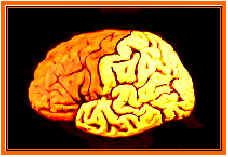Brain Research in the Foreign Language Classroom
VER ESTA PÁGINA EN ESPAÑOL
 Creating a Brain-Compatible
Classroom Environment.
Creating a Brain-Compatible
Classroom Environment.
Research on Early Language Learning
Snowball effect helps kids' language explode (August 2007)
Learning a second language: When and why
(November 2006)
Neuroscientists have discovered why children excel at learning languages...
Current Research on Language Development
Raising Children Bilingual: Common Parental Concerns and Current Research (2006)
Examining the methods that enhance first language learning and the types of activities and environments that positively affect the learning process provides teachers with an insight into creating a brain-compatible classroom. Almost all language skills for young children are acquired through natural language acquisition experiences. The natural approach to language learning outlined by Krashen & Terrell (1983) maintains that beginning language learners should be taught a new language in the same manner that they acquired their first.
The Natural Approach to teaching new languages encourages listening and understanding before developing skills in speaking, reading and writing.
Article from News in Science (2002)
Theories have been developed to investigate the optimal age to undertake the study of a second language. Research has shown that the Brain Plasticity Theory (Baker, 1993; Chugani, 1996; Nash, 1997), the Biological Predisposition Theory (Lemke, 1990; Genesee, 1996), the Imprinting Theory (Asher & Garcia, 1984; Celestino, 1993; Hart, 1983) and the Native Language Magnet Theory (Kuhl, 1994) commonly share the theme that the younger the individual is when he/she is exposed to a new language, the greater the probability of acquiring native pronunciation as well as proficiency in that language. Lending further support to this theory, Begley (1996) refers to the brain as a jumble of neurons that are waiting to be woven into the intricate tapestry of the mind. She further describes the neurons of the newborn’s mind as unprogrammed circuits of almost infinite potential, comparable to the pentium chips found in a computer before the factory has preloaded the software. Begley reports that the circuits in the auditory cortex of the brain are wired by the age of 1 year, concluding further that the learning window for total language learning is from birth to 10 years of age. Begley warns that the critical periods for language learning close with each child’s passing birthday.
More
recent research has concluded that the window for acquiring syntax may close as
early as age 5 or 6, while the window allowing for the addition of new words may
never close (Nash, 1997). However,
Nash states that the ability to learn a second language undergoes a steady and
inexorable decline after the age of 6. Curtiss,
UCLA Professor of Linguistics, states that after this critical period, the brain
becomes slowly less plastic, so that by the time the child reaches adolescence
the brain cannot normally develop any new cognitive system, including language
(“Language Learning and the Developing Brain”, 1996).
Others have documented studies that support early language acquisition
and believes that there clearly appears to be a “window of opportunity” when
the brain is particularly efficient in learning (Chugani, 1996).
Information released from Dr. Phelps of the Department of Molecular and
Medical Pharmacology of the UCLA School of Medicine states that the learning
experiences of a child determine which connections in the brain become developed
and which will no longer function (“Language Learning and the Developing
Brain”, 1996). Phelps also
documented studies that have shown that the brain of a two-year-old has twice as
many synapses or connections as an adult’s brain. Consequently, the failure to
learn a skill during this sensitive period holds important significance because
the young brain must use these connections or they will be lost.
Since
the fixing of speech habits occurs at about
the age of 10, the consequent age barrier in language acquisition is directly linked to psychological as well as neurophysiological factors (Clyne,
1983; Krashen, 1976).